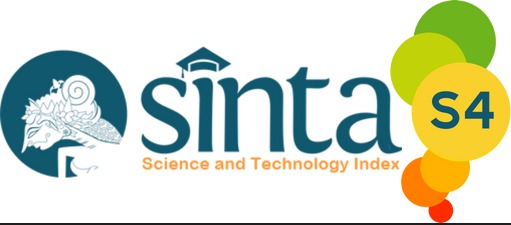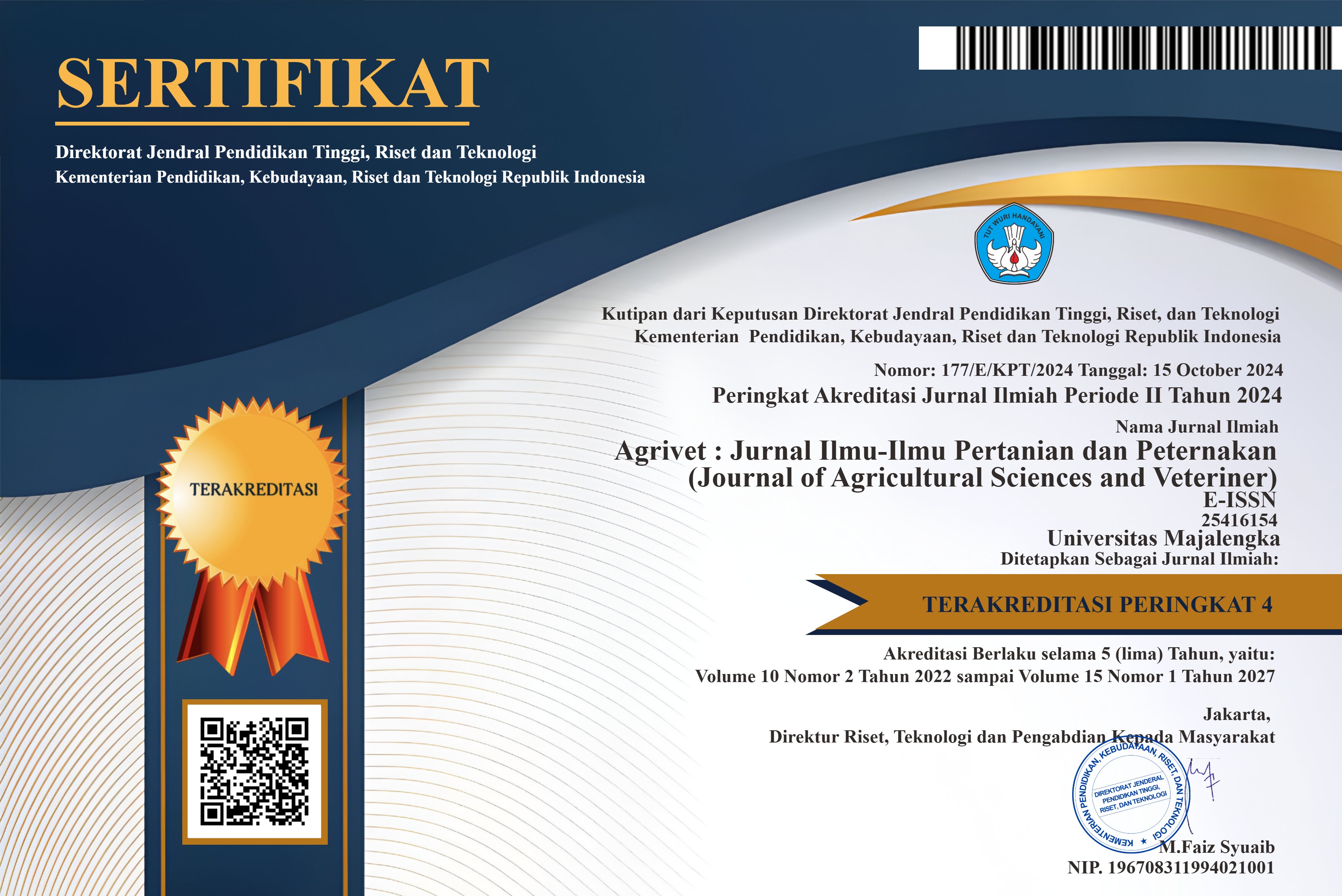Respon pertumbuhan dan hasil tanaman selada romaine (Lactuca sativa L. var. Longifolia) terhadap pemberian berbagai dosis pupuk bekas budidaya maggot (kasgot)
DOI:
https://doi.org/10.31949/agrivet.v13i1.13807Abstract
The romaine lettuce plant is a plant whose production continues to increase so that the demand for romaine lettuce in Indonesia is not sufficient due to inefficient cultivation. This means that romaine lettuce plants have to be imported to meet the needs of the community but do not meet market needs. Providing cassava fertilizer from household waste feed is one effort to meet the nutritional needs of romaine lettuce, so that production can increase. This research aims to determine the effect of different doses of cassava fertilizer on the growth and yield of romaine lettuce plants (Lactuca sativa L. var longifolia.). This research was carried out from February to July 2024 at the Land Balai Pengembangan dan Produksi Benih Perkebunan (BPPBP) and at Labolatorium Teknologi Benih Universitas Sunan Gunung Djati Bandung. This research used a Randomized Group Design (RAK) consisting of 6 treatments and 4 replications. Each experimental unit contained 3 plant samples, so that 72 plant samples were obtained (A= Control (soil); B= Kasgot organic fertilizer 9 t ha-1; B= Kasgot organic fertilizer 10 t ha-1; C= Kasgot organic fertilizer 11 t ha-1; D= Kasgot organic fertilizer 12 t ha-1; F= NPK 16:16:16). The results of the study showed that the use of cashew fertilizer with household waste feed had an effect on the growth and yield of romaine lettuce plants with an effective dose of 10 t ha-1.
Keywords:
fertilizer, growth, maggot, romaine lettuce, yieldDownloads
References
Agustin, H., & Musadik, I. M. 2023. Kandungan Nutrisi Kasgot Larva Lalat Tentara Hitam (Hermetia illucens) Sebagai Pupuk Organik. Jurnal XYZ 25(1):12–18.
Akbar, Syarif, A., Ikmal, M. I., & Jumiati. 2022. Penguatan Kelembagaan Lokal Dalam Pengembangan Agribisnis Hortikultura di Kecamatan Uluere Kabupaten Bantaeng. Jurnal Sosial Ekonomi Pertanian 18(2):159–174. https://journal.unhas.ac.id/index.php/jsep
Alizahatie, H. 2019. Budidaya Black Soldier Fly dengan Memanfaatkan Limbah Rumah Tangga sebagai Alternatif Pakan Ikan Air Tawar dan Unggas.
Banurea, A. J. 2021. Respon Pertumbuhan dan Produksi Tanaman Kailan (Brassica oleraceae L.) Terhadap Pemberian Pupuk Kandang Sapi dan NPK 16:16:16. Jurnal Ilmiah Mahasiswa Pertanian (JIMTANI) 1(4):1–14. http://jurnalmahasiswa.umsu.ac.id/index.php/jimtani/article/view/942
Dendi, Supriyono, dan B. P. 2014. Pengaruh Pemberian Pupuk NPK terhadap Pertumbuhan dan Hasil Rumput Meksiko (Euchlaena mexicana) Pada Tanah Ultisol. Cryobiology 69(3):510. https://doi.org/10.1016/j.cryobiol.2014.09.318
Dini, A. Z. D., Yuwariah, Y., Wicaksono, F. Y., & Ruswandi, D. 2018. Pertumbuhan dan Hasil Tanaman Jagung (Zea mays L.) pada Pola Tanam Tumpangsari dengan Ubi Jalar (Ipomoea batatas (L.) Lam) di Arjasari Kabupaten Bandung. Jurnal Agrotek Indonesia 3(2):113–120. https://doi.org/10.33661/jai.v3i2.1375
Kare, B. D. Y., Sukerta, M., Javandira, C., & Ananda, K. D. 2023. Pengaruh Pupuk Kasgot Terhadap Pertumbuhan dan Hasil Tanaman Sawi Pakcoy (Brassica rapa L.). Agrimeta: Jurnal Pertanian Berbasis Keseimbangan Ekosistem 13(25):59–66. https://e-journal.unmas.ac.id/index.php/agrimeta/article/view/6491/4950
Maryam, A., Susila, A. D., & Kartika, J. G. 2015. Pengaruh Jenis Pupuk Organik terhadap Pertumbuhan dan Hasil Panen Tanaman Sayuran di dalam Nethouse. Buletin Agrohorti 3(2):263–275. https://doi.org/10.29244/agrob.v3i2.15109
MS, A. P., Mutakin, J., & Nafia’ah, H. H. 2021. Pengaruh Berbagai Konsentrasi Pupuk Organik Cair (POC) Azolla pinnata dan Jarak Tanam terhadap Pertumbuhan dan Hasil Tanaman Sawi Hijau (Brassica juncea L.). JAGROS: Jurnal Agroteknologi dan Sains 6(1):65. https://doi.org/10.52434/jagros.v6i1.1621
Muhammad Fauzi, Luhtfia Hastiani M., Qori Atur Suhada R., & N. H. 2022. Pengaruh Pupuk Kasgot (Bekas Maggot) Magotsuka terhadap Tinggi, Jumlah Daun, Luas Permukaan Daun dan Bobot Basah Tanaman Sawi Hijau (Brassica rapa var. Parachinensis). Jurnal XYZ 20(1):20–30.
Novitasari, D. 2020. Analisis Kelayakan Finansial Budidaya Selada dengan Hidroponik Sederhana Skala Rumah Tangga. SEPA: Jurnal Sosial Ekonomi Pertanian dan Agribisnis 17(1):19. https://doi.org/10.20961/sepa.v17i1.38060
Priambodo, L. H., & Najib, M. 2016. Analisis Kesediaan Membayar (Willingness to Pay) Sayuran Organik dan Faktor-Faktor yang Mempengaruhinya. Jurnal Manajemen dan Organisasi 5(1):1. https://doi.org/10.29244/jmo.v5i1.12125
Sagala, D. n.d. Teknologi Pupuk Slow Release Sebagai Alternatif Pemupukan Ramah Lingkungan: Penggunaan Arang Kayu. 1:1–17.
Wijiyanti, P., Hastuti, E. D., & Haryanti, S. 2019. Pengaruh Masa Inkubasi Pupuk dari Air Cucian Beras Terhadap Pertumbuhan Tanaman Sawi Hijau (Brassica juncea L.). Buletin Anatomi dan Fisiologi 4(1):21–28. https://doi.org/10.14710/baf.4.1.2019.21-28
Zulkifli, Z., Mulyani, S., Saputra, R., & Pulungan, L. A. B. 2022. Hubungan Antara Panjang dan Lebar Daun Nanas Terhadap Kualitas Serat Daun Nanas Berdasarkan Letak Daun dan Lama Perendaman Daun. Jurnal Agrotek Tropika 10(2):247. https://doi.org/10.23960/jat.v10i2.5461
Published
How to Cite
Issue
Section
License
Copyright (c) 2025 Ahmad Taofik, Astiana Rizky, Liberty Chaidir

This work is licensed under a Creative Commons Attribution-ShareAlike 4.0 International License.
An author who publishes in the Jurnal Agrivet agrees to the following terms:
- Author retains the copyright and grants the journal the right of first publication of the work simultaneously licensed under the Creative Commons Attribution-ShareAlike 4.0 License that allows others to share the work with an acknowledgment of the work's authorship and initial publication in this journal
- The author is able to enter into separate, additional contractual arrangements for the non-exclusive distribution of the journal's published version of the work (e.g., post it to an institutional repository or publish it in a book) with the acknowledgment of its initial publication in this journal.
- The author is permitted and encouraged to post his/her work online (e.g., in institutional repositories or on their website) prior to and during the submission process, as it can lead to productive exchanges, as well as earlier and greater citation of the published work











